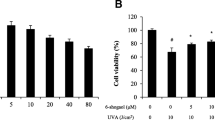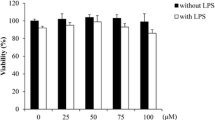Abstract
Chinese hamster pulmonary fibroblasts (V79 cells) pre-treated with flax fabrics derived from non-modified or genetically engineered flax fibres and treated with H2O2 revealed a markedly lower level of intracellular reactive oxygen species (ROS) than control, non-pre-treated cells. The fabrics were prepared from fibres derived from two kinds of transgenic plants: W92 plants, which overproduce flavonoids, and M type plants, which produce hydroxybutyrate polymer in their vascular bundles and thus in fibres. Incubating the V79 cells with the flax fabrics prior to H2O2 treatment also reduced the amount of DNA damage, as established using the comet assay (also known as alkaline single-cell gel electrophoresis) and pulsed-field electrophoresis of intact cellular DNA. Selected gene expression analysis revealed the activator impact of fabrics on the apoptotic (BCL2 family, caspases) gene expression. This promoting activity was also detected for histone acetyltransferase (HAT; MYST2) gene expression. The flax fabric derived from both GM flax plants exhibited a protective effect against oxidative stress and ROS-mediated genotoxic damage, but the W92 fabric was the strongest. It is thus suggested that these fabrics might be useful as a basis for new biomedical products (e.g. wound dressings) that actively protect cells against inflammation and degeneration.




Similar content being viewed by others
References
Martin, K. R., & Barrett, J. C. (2002). Reactive oxygen species as double-edged swords in cellular processes: low-dose cell signaling versus high-dose toxicity. Human & experimental toxicology., 21(2), 71–75.
Colavitti, R., & Finkel, T. (2005). Reactive oxygen species as mediators of cellular senescence. IUBMB Life, 57(4–5), 277–281.
Kim, M. R., Lee, H. S., Choi, H. S., Kim, S. Y., Park, Y., & Suh, H. J. (2014). Protective effects of ginseng leaf extract using enzymatic extraction against oxidative damage of UVA-irradiated human keratinocytes. Applied Biochemistry and Biotechnology, 173(4), 933–945.
Kregel, K. C., & Zhang, H. J. (2007). An integrated view of oxidative stress in aging: basic mechanisms, functional effects, and pathological considerations. American journal of physiology Regulatory, integrative and comparative physiology., 292(1), R18–R36.
Valko, M., Leibfritz, D., Moncol, J., Cronin, M. T. D., Mazur, M., & Telser, J. (2007). Free radicals and antioxidants in normal physiological functions and human disease. The international journal of biochemistry & cell biology., 39(1), 44–84.
Chen, J.-H., Hales, C. N., & Ozanne, S. E. (2007). DNA damage, cellular senescence and organismal ageing: causal or correlative? Nucleic acids research., 35(22), 7417–7428.
Beckman, K. B., & Ames, B. N. (1998). The free radical theory of aging matures. Physiological Reviews, 78(2), 547–581.
Park, M. H., Heo, S. J., Park, P. J., Moon, S. H., Sung, S. H., Jeon, B. T., & Lee, S. H. (2014). 6,6′-bieckol isolated from Ecklonia cava protects oxidative stress through inhibiting expression of ROS and proinflammatory enzymes in high-glucose-induced human umbilical vein endothelial cells. Applied Biochemistry and Biotechnology, 174(2), 632–643.
Halliwell, B. (2007). Oxidative stress and cancer: have we moved forward? The Biochemical journal., 401(1), 1–11.
Ames, B. N., Shigenaga, M. K., & Hagen, T. M. (1993). Oxidants, antioxidants, and the degenerative diseases of aging. Proceedings of the National Academy of Sciences of the United States of America., 90(17), 7915–7922.
Grimes, A., & Chandra, S. B. C. (2009). Significance of cellular senescence in aging and cancer. Cancer research and treatment : official journal of Korean Cancer Association., 41(4), 187–195.
Massaro, M., Scoditti, E., Carluccio, M. A., & De Caterina, R. (2010). Nutraceuticals and prevention of atherosclerosis: focus on omega-3 polyunsaturated fatty acids and Mediterranean diet polyphenols. Cardiovascular therapeutics., 28(4), e13–e19.
Cushnie, T. P. T., & Lamb, A. J. (2005). Antimicrobial activity of flavonoids. International journal of antimicrobial agents., 26(5), 343–356.
Ryan, K. G., Swinny, E. E., Markham, K. R., & Winefield, C. (2002). Flavonoid gene expression and UV photoprotection in transgenic and mutant petunia leaves. Phytochemistry, 59(1), 23–32.
Hernandez, N. E., Tereschuk, M. L., & Abdala, L. R. (2000). Antimicrobial activity of flavonoids in medicinal plants from Tafi del Valle (Tucuman, Argentina). Journal of Ethnopharmacology, 73(1–2), 317–322.
Harborne, J. B., & Williams, C. A. (2000). Advances in flavonoid research since 1992. Phytochemistry, 55(6), 481–504.
Olchowik-Grabarek, E., Mavlyanov, S., Abdullajanova, N., Gieniusz, R., & Zamaraeva, M. (2017). Specificity of hydrolysable tannins from Rhus typhina L. to oxidants in cell and cell-free models. Applied Biochemistry and Biotechnology, 181(2), 495–510.
Lorenc-Kukula, K., Amarowicz, R., Oszmianski, J., Doermann, P., Starzycki, M., Skala, J., Zuk, M., Kulma, A., & Szopa, J. (2005). Pleiotropic effect of phenolic compounds content increases in transgenic flax plant. Journal of agricultural and food chemistry., 53(9), 3685–3692.
Wrobel, M., Zebrowski, J., & Szopa, J. (2004). Polyhydroxybutyrate synthesis in transgenic flax. Journal of Biotechnology, 107(1), 41–54.
Szopa, J., Wrobel-Kwiatkowska, M., Kulma, A., Zuk, M., Skorkowska-Telichowska, K., Dyminska, L., Maczka, M., Hanuza, J., Zebrowski, J., & Preisner, M. (2009). Chemical composition and molecular structure of fibers from transgenic flax producing polyhydroxybutyrate, and mechanical properties and platelet aggregation of composite materials containing these fibers. Composites Science and Technology, 69(14), 2438–2446.
Cheng, S., Chen, G. Q., Leski, M., Zou, B., Wang, Y., & Wu, Q. (2006). The effect of D,L-beta-hydroxybutyric acid on cell death and proliferation in L929 cells. Biomaterials, 27(20), 3758–3765.
Wrobel-Kwiatkowska, M., Zebrowski, J., Starzycki, M., Oszmianski, J., & Szopa, J. (2007). Engineering of PHB synthesis causes improved elastic properties of flax fibers. Biotechnology Progress, 23(1), 269–277.
Subba Rao, M. V. S. S. T., & Muralikrishna, G. (2002). Evaluation of the antioxidant properties of free and bound phenolic acids from native and malted finger millet (ragi, Eleusine coracana Indaf-15). Journal of agricultural and food chemistry., 50(4), 889–892.
Vichai, V., & Kirtikara, K. (2006). Sulforhodamine B colorimetric assay for cytotoxicity screening. Nature Protocols, 1(3), 1112–1116.
Rhee, S. G., Chang, T. S., Jeong, W., & Kang, D. (2010). Methods for detection and measurement of hydrogen peroxide inside and outside of cells. Molecules and Cells, 29(6), 539–549.
Kalyanaraman, B., Darley-Usmar, V., Davies, K. J., Dennery, P. A., Forman, H. J., Grisham, M. B., Mann, G. E., Moore, K., Roberts II, L. J., & Ischiropoulos, H. (2012). Measuring reactive oxygen and nitrogen species with fluorescent probes: challenges and limitations. Free Radical Biology & Medicine, 52(1), 1–6.
Darzynkiewicz, Z., Juan, G., Li, X., Gorczyca, W., Murakami, T., & Traganos, F. (1997). Cytometry in cell necrobiology: analysis of apoptosis and accidental cell death (necrosis). Cytometry, 27(1), 1–20.
van Engeland, M., Nieland, L. J., Ramaekers, F. C., Schutte, B., & Reutelingsperger, C. P. (1998). Annexin V-affinity assay: a review on an apoptosis detection system based on phosphatidylserine exposure. Cytometry, 31(1), 1–9.
Collins, A. R. (2004). The comet assay for DNA damage and repair: principles, applications, and limitations. Molecular Biotechnology, 26(3), 249–261.
Speit, G., & Hartmann, A. (2005). The comet assay: a sensitive genotoxicity test for the detection of DNA damage. Methods in Molecular Biology, 291, 85–95.
Gasiorowski, K., & Brokos, B. (2001). DNA repair of hydrogen peroxide-induced damage in human lymphocytes in the presence of four antimutagens. A study with alkaline single cell gel electrophoresis (comet assay). Cellular & molecular biology letters., 6(4), 897–911.
Olive, P. L., Wlodek, D., Durand, R. E., & Banath, J. P. (1992). Factors influencing DNA migration from individual cells subjected to gel electrophoresis. Experimental cell research., 198(2), 259–267.
Gasiorowski, K., Brokos, B., Kulma, A., Ogorzalek, A., & Skorkowska, K. (2001). Impact of four antimutagens on apoptosis in genotoxically damaged lymphocytes in vitro. Cellular & molecular biology letters., 6(3), 649–675.
Gorshkova, T. A., Salnikov, V. V., Pogodina, N. M., Chemikosova, S. B., Yablokova, E. V., Ulanov, A. V., Ageeva, M. V., Van Dam, J. E. G., & Lozovaya, V. V. (2000). Composition and distribution of cell wall phenolic compounds in flax (Linum usitatissimum L.) stem tissues. Annals of Botany., 85(4), 477–486.
Skorkowska-Telichowska, K., Zuk, M., Kulma, A., Bugajska-Prusak, A., Ratajczak, K., Gasiorowski, K., Kostyn, K., & Szopa, J. (2010). New dressing materials derived from transgenic flax products to treat long-standing venous ulcers—a pilot study. Wound repair and regeneration : official publication of the Wound Healing Society [and] the European Tissue Repair Society., 18(2), 168–179.
Natella, F., Nardini, M., Di Felice, M., & Scaccini, C. (1999). Benzoic and cinnamic acid derivatives as antioxidants: structure-activity relation. Journal of agricultural and food chemistry., 47(4), 1453–1459.
Sapountzi, V., & Cote, J. (2011). MYST-family histone acetyltransferases: beyond chromatin. Cellular and Molecular Life Sciences, 68(7), 1147–1156.
Hamaishi, K., Kojima, R., & Ito, M. (2006). Anti-ulcer effect of tea catechin in rats. Biological & pharmaceutical bulletin., 29(11), 2206–2213.
Czemplik, A., Boba, A., Kostyn, A., Kulma, A., Agnieszka, M., Sztajnert, M., Wróbel-Kwiatkowska, M., Żuk, M., Szopa, J., & Skórkowska-Telichowska, K. (2011). Flax engineering for biomedical application. In M. A. Komorowska, S. Olsztynska-Janus (Eds.), Biomedical engineering, trends, research and technologies (pp. 407–434). INTECH, http://www.intechopen.com/books/biomedical-engineering-trends-research-and-technologies/flax-engineering-for-biomedical-application.
Skorkowska-Telichowska, K., Kulma, A., Zuk, M., Czuj, T., & Szopa, J. (2012). The effects of newly developed linen dressings on decubitus ulcers. Journal of palliative medicine., 15(2), 146–148.
Skorkowska-Telichowska, K., Czemplik, M., Kulma, A., & Szopa, J. (2011). The local treatment and available dressings designed for chronic wounds. Journal of the American Academy of Dermatology, 68(4), 117–126.
Ivanovas, B., Zerweck, A., & Bauer, G. (2002). Selective and non-selective apoptosis induction in transformed and non-transformed fibroblasts by exogenous reactive oxygen and nitrogen species. Anticancer Research, 22(2A), 841–856.
Solovyan, V. T. (2007). Characterization of apoptotic pathway associated with caspase-independent excision of DNA loop domains. Experimental cell research., 313(7), 1347–1360.
Solov'yan, V. T., Andreev, I. O., Kolotova, T. Y., Pogribniy, P. V., Tarnavsky, D. T., & Kunakh, V. A. (1997). The cleavage of nuclear DNA into high molecular weight DNA fragments occurs not only during apoptosis but also accompanies changes in functional activity of the nonapoptotic cells. Experimental cell research., 235(1), 130–137.
Solovyan, V. T., Bezvenyuk, Z. A., Salminen, A., Austin, C. A., & Courtney, M. J. (2002). The role of topoisomerase II in the excision of DNA loop domains during apoptosis. The Journal of biological chemistry., 277(24), 21458–21467.
Acknowledgements
This study was supported by grant NCBiR 178676 from the Polish Ministry of Science and Education and by Wroclaw Centre of Biotechnology, MAESTRO, from National Science Centre grant no. 2012/06/A/NZ1/00006, the Leading National Research Centre (KNOW) programme for the years 2014–2018.
Author information
Authors and Affiliations
Contributions
KST–coordinated the experiments within this manuscript and performed the data analysis, AKu–wrote the manuscript, TGe–did cell cultures and comet assays, WWo–did the gene expression analysis, KKo–participated in writing of the manuscript and prepared the manuscript for submission, HMo–performed the flow cytometry analysis, ASz–cell viability tests, ABo–did the metabolite analysis, MPr–did antioxidative assay, JMr–participated in the gene expression analysis, MAr–did pulse field electrophoresis, AKo–did the statistical analysis, MSz–participated in the metabolite analysis, JSz–general supervision, KGa–general idea of the publication.
All authors have approved the final article.
Corresponding author
Ethics declarations
Conflict of Interests
The authors declare that they have no conflict of interests.
Rights and permissions
About this article
Cite this article
Skórkowska-Telichowska, K., Kulma, A., Gębarowski, T. et al. V79 Fibroblasts Are Protected Against Reactive Oxygen Species by Flax Fabric. Appl Biochem Biotechnol 184, 366–385 (2018). https://doi.org/10.1007/s12010-017-2552-y
Received:
Accepted:
Published:
Issue Date:
DOI: https://doi.org/10.1007/s12010-017-2552-y




